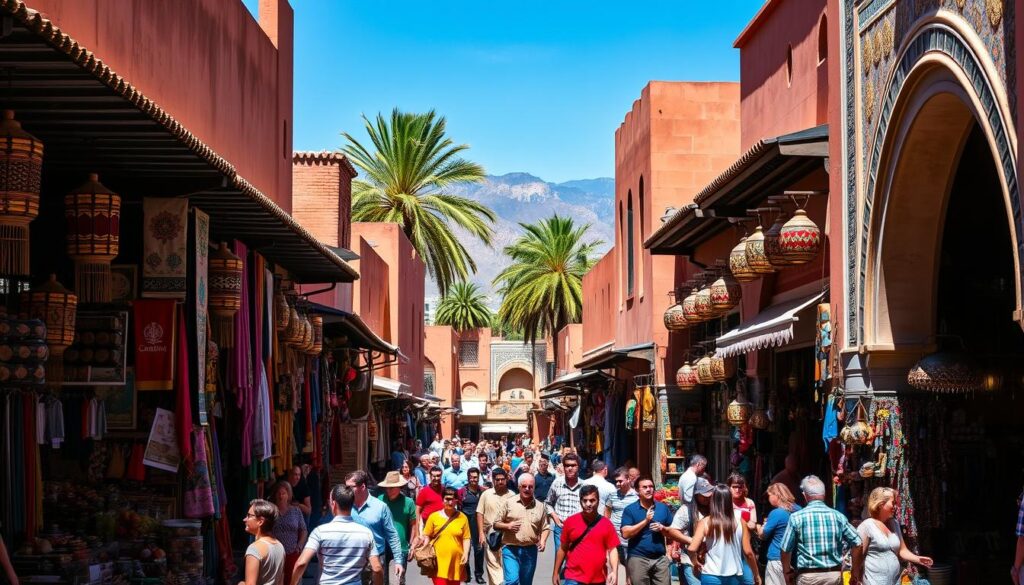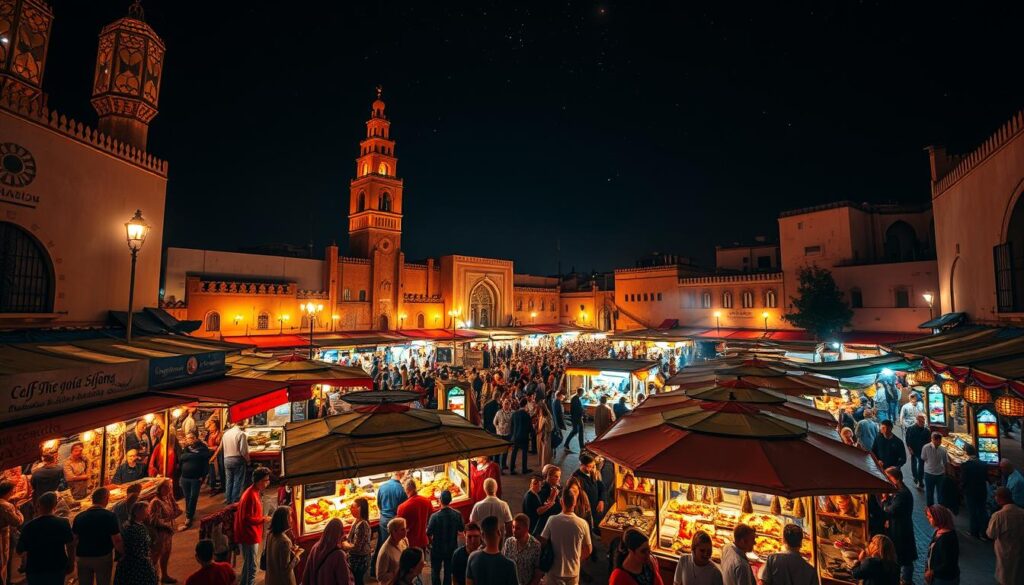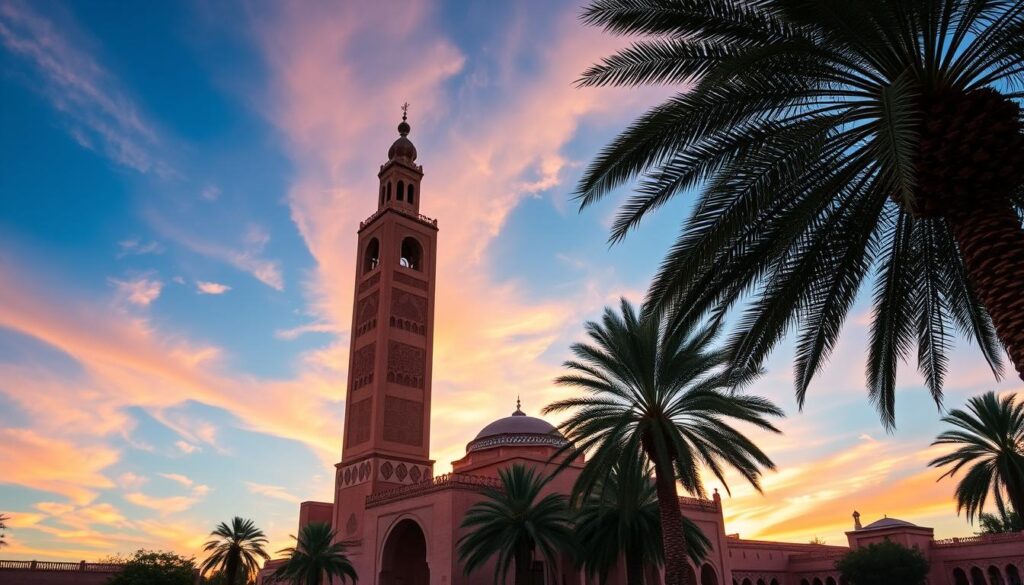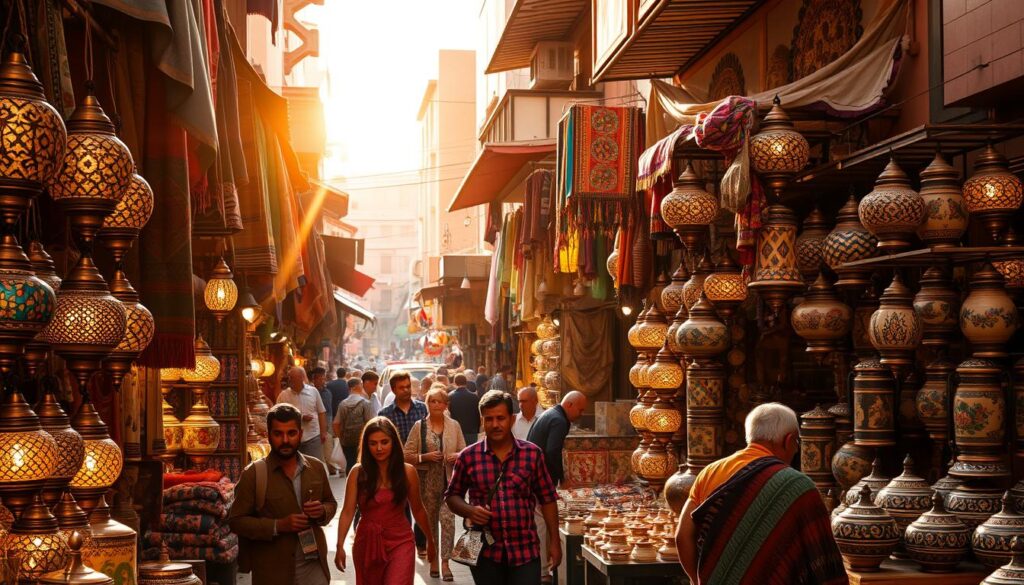Things to do in Marrakech abound in this vibrant Moroccan city full of history, culture, and sensory experiences. The winding Medina streets and bustling Jemaa el-Fnaa square offer endless adventures. From ancient palaces to traditional hammams, Marrakech has it all.
Must-see attractions include the majestic Koutoubia Mosque and serene Jardin Majorelle. Bargaining in the souks and admiring Moorish architecture are unforgettable experiences. These top activities will leave you spellbound.
Despite recent challenges, Marrakech remains resilient and welcoming to visitors. The city offers a mix of luxury and tradition to suit various budgets. You can find $200 rooms at Jadali Hotel & Spa or enjoy 750 dirham dinners at Sahbi Sahbi.
Key Takeaways
- Marrakech offers a diverse range of activities, from historical sites to modern art galleries.
- The Medina and Jemaa el-Fnaa square are must-visit spots for an authentic Moroccan experience.
- Marrakech’s markets are central to the city’s culture, offering a variety of goods and haggling opportunities.
- The city boasts beautiful gardens, including the famous Jardin Majorelle.
- Marrakech serves as a gateway to the Atlas Mountains, offering additional adventure opportunities.
- The city offers a range of dining and accommodation options to suit various budgets.
Exploring the Vibrant Medina
The Medina of Marrakech is a UNESCO World Heritage site. It’s the beating heart of this magical city. As I walked through the old town, I was swept up in its colors and scents.
Getting lost in the winding streets
The Medina’s maze-like alleys are an adventure. Use Maps.me or Google Maps to find your way. Don’t worry if you get a bit lost.
The narrow streets hide treasures at every turn. This makes it one of the best sights in Marrakech.
Discovering hidden gems and local shops
The Medina is a shopping paradise. It’s full of local artisans selling their wares. I haggled for colorful textiles, metalwork, and spices.
Bargaining is part of the fun here! Consider booking a guide for a deeper experience. They can offer insights and help you navigate the busy markets.
Experiencing the authentic Moroccan atmosphere
The Medina is a feast for the senses. The air is filled with mint, leather, and the smell of local food. I learned some Arabic to chat with locals.
Remember to dress modestly here. Cover your shoulders and knees to respect local customs.
The Medina is not just a place to visit, it’s a living, breathing testament to Moroccan culture and history.
The Medina offers a journey through time and tradition. From Ben Youssef Madrassa to hidden riads, every alley tells a story. Every corner holds a new discovery.
Immersing in the Chaos of Jemaa el-Fnaa Square
Jemaa el-Fnaa is Marrakech’s vibrant core. This lively square transforms from day to night, offering a sensory feast. I watched snake charmers and monkey handlers entertain crowds during the day.
As night fell, the square became an open-air spectacle. Food stalls emerged, filling the air with spicy aromas. Storytellers and musicians added to the bustling scene.
This UNESCO site is a top Marrakech attraction. It’s most exciting after dark, making it a must-visit nighttime spot.
I climbed to a rooftop café for a bird’s-eye view. Sipping mint tea, I gazed at the action below. Experiencing Jemaa el-Fnaa from above and ground level is best.
The square is a whirlwind of colors, sounds, and smells that awaken all your senses at once.
Jemaa el-Fnaa feels like entering another world. Here, old traditions mix with modern life. You can try local foods, watch performers, or soak in the atmosphere.
This iconic square offers an unforgettable Moroccan experience. It’s a place where past and present collide in a vibrant display.
Marveling at the Koutoubia Mosque
The Koutoubia Mosque is an iconic Marrakech landmark. Its 77-meter minaret makes it the city’s largest mosque. The structure’s grandeur and beauty are truly awe-inspiring.
Admiring the architectural beauty
The mosque showcases exquisite Moorish architecture, capturing Islamic design’s essence. Its intricate stonework and elegant arches highlight 12th-century craftsmanship. The minaret has inspired other famous structures, like Seville’s Giralda.
Learning about its historical significance
Built in the 1100s, the Koutoubia Mosque holds deep historical importance. It’s a symbol of Marrakech’s rich cultural heritage. Although non-Muslims can’t enter, its exterior captivates visitors.
Enjoying the surrounding gardens
Beautiful gardens surround the mosque, offering a peaceful retreat. These lush green spaces feature fragrant flowers and gentle fountains. It’s perfect for relaxing after exploring other Marrakech attractions.
The Koutoubia Mosque is a top sight in Marrakech. Its stunning architecture, history, and serene gardens make it unmissable. Visitors to this vibrant city shouldn’t miss this remarkable landmark.
Indulging in a Traditional Hammam Experience
A hammam marrakech experience is a popular attraction in Marrakech. This traditional Moroccan bath blends relaxation and cleansing. The city offers many options, from public bathhouses to luxurious private spas.
The Hammam Mouassine, built in 1562, is Marrakech’s oldest public hammam. Public hammams like Les Bains Ziani provide affordable options. Entry fees range from 50 to 200 dirhams, with extra charges for scrubbing.
Private hammams cater to tourists seeking luxurious experiences. The Royal Mansour Hammam offers indulgent sessions lasting up to two hours. Prices range from 1,400 to 3,200 dirhams.
For a mid-range option, try Hammam de la Rose. They offer six different moroccan bath experiences. The popular oriental hammam costs 250 dirhams.
- Traditional hammam lasts about 1.5 hours
- Locals visit weekly, often before mosque services
- Experiences include steam rooms, exfoliation, and optional massages
This centuries-old tradition is a must-try experience in Marrakech. It’s a perfect way to unwind and immerse yourself in Moroccan culture.
Visiting the Stunning Bahia Palace
The Bahia Palace is a top Marrakech attraction. It covers 22,000 square meters, making it a must-see. This grand palace offers plenty to explore in Marrakech.
Exploring the Intricate Moorish Architecture
The palace’s Moorish design is breathtaking. Colorful wooden ceilings and elaborate pavilions showcase fine Moroccan craftsmanship. Traditional Zellige tiling adds to its beauty, recognized as a historical monument in 1922.
Discovering the Palace’s Rich History
Built in 1859, the Bahia Palace has a captivating past. It once housed 6,000 servants, showing its grandeur. Today, it’s one of Morocco’s most popular tourist sites.
In early 2019, over 410,000 tourists explored its halls. This number shows the palace’s enduring appeal to visitors.
Enjoying the Tranquil Courtyards and Gardens
The palace’s marble courtyards and lush gardens offer peace. These spaces provide a break from Marrakech’s busy streets. For the best experience, arrive early around 9 AM.
The entrance fee is 70 MAD (about $7). The palace opens from 8 AM to 5 PM on Fridays. Other days, it’s open from 9 AM to 4:30 PM.
Guided tours are available for those wanting to learn more. Some visitors note the lack of original furniture. Still, the Bahia Palace remains a gem among Marrakech palaces.
Things to do in Marrakech: Bargaining in the Souks
Marrakech souks offer a vibrant maze of narrow alleys filled with colorful shops. These bustling markets showcase local life and culture. Wandering through winding streets, I’m surrounded by goods from spices to intricate carpets.
Shopping in Marrakech is an exciting adventure. Souks are organized by trade, making it easy to find specific items. I love browsing Souk Semmarine for textiles and Souk des Bijoutiers for jewelry.
The variety is stunning – handmade leather goods, traditional clothing, and ornate lamps abound. Bargaining is crucial in the souk experience. Shopkeepers often start high, expecting negotiation.
I’ve learned to haggle with a smile, starting at about half the asking price. It’s okay to walk away if we can’t agree on a price.
“In Marrakech’s souks, the art of negotiation is as colorful as the goods on display.”
While exploring, I always keep an eye on my belongings. Crowded alleys can attract pickpockets, so stay alert. For newcomers, a local guide can help navigate and find great deals.
- Leather goods: wallets, belts, bags, shoes
- Textiles: carpets, Berber rugs, traditional clothing
- Artisan crafts: silver jewelry, artwork, lamps
- Culinary delights: spices, preserved lemons, olives
The souks are a must-see attraction in Marrakech. They create an unforgettable sensory experience. The atmosphere captivates me, whether I’m souvenir hunting or just taking it all in.
Escaping to the Serene Jardin Majorelle
Jardin Majorelle offers a peaceful retreat from Marrakech’s bustling streets. This two-and-a-half-acre botanical garden is a must-see attraction in Marrakech. French painter Jacques Majorelle created this living masterpiece of art and nature in the 1920s.
Strolling through Exotic Plant Collections
The garden’s paths showcase diverse flora from five continents. Towering cacti, swaying palms, and vibrant bougainvillea create a lush oasis. The Fondation Jardin Majorelle works to preserve this living artwork for future visitors.
Visiting the Yves Saint Laurent Museum
Next to the garden, the YSL Museum Marrakech displays the legendary designer’s work. The Art Deco villa offers a glimpse into Saint Laurent’s fashion influence. It highlights his love for Marrakech and its impact on his designs.
Enjoying the Vibrant Blue Architecture
The garden’s striking cobalt blue villa catches the eye. This vivid hue, called Majorelle Blue, contrasts beautifully with the lush greenery. At twilight, the garden transforms into a magical setting under the stars.
Jardin Majorelle blends art, nature, and fashion uniquely among Marrakech gardens. It provides a tranquil escape and showcases the city’s rich cultural heritage. This serene oasis offers an unforgettable experience for Marrakech visitors.
Exploring the Saadian Tombs
The Saadian Tombs are a hidden gem among Marrakech attractions. Built in the 16th century, they offer a fascinating glimpse into Marrakech history. These tombs lay forgotten for centuries until aerial photography revealed their existence in 1917.
The Chamber of the 12 Pillars is the heart of the Saadian Tombs. This stunning room features three groups of four marble pillars. Two of these pillar groups came from the ancient Roman city of Volubilis.
The complex includes the Chamber of Three Niches and the Prayer Room. Sultan Ahmed Al Mansour’s mother’s tomb sits in a recessed niche. This adds a touch of familial reverence to the site.
For the best experience, visit early in the morning to avoid crowds. Late afternoon offers the most flattering light for photography enthusiasts. About 170 chancellors were buried in the garden area.
The Saadian Tombs showcase Marrakech’s rich past. They join other landmarks like the Bahia Palace and El Badi Palace. Together, these sites highlight the city’s royal heritage.
FAQ
What are some of the top attractions in Marrakech?
Marrakech boasts many captivating sights. The Medina, Jemaa el-Fnaa Square, and Koutoubia Mosque are must-see landmarks. Bahia Palace, the souks, Jardin Majorelle, and Saadian Tombs also charm visitors.
What is the Medina, and what can I experience there?
The Medina is Marrakech’s historic heart, a UNESCO World Heritage site. Its winding streets house local shops, hidden riads, and authentic Moroccan culture.
Visitors can explore historical sites and witness daily life. The vibrant colors and traditional architecture create an unforgettable atmosphere.
What makes Jemaa el-Fnaa Square so special?
Jemaa el-Fnaa Square is a UNESCO Masterpiece in Marrakech’s Medina. By day, street performers entertain crowds.
At night, it transforms into a lively open-air dining area. Food stalls, storytellers, and musicians create a magical ambiance.
Can non-Muslims visit the Koutoubia Mosque?
Non-Muslims can’t enter Koutoubia Mosque. However, visitors can admire its stunning Moorish architecture from outside. The intricate stonework and surrounding gardens are worth exploring.
What is a hammam, and why should I experience one in Marrakech?
A hammam is a traditional Moroccan bathhouse offering cleansing and relaxation. It’s a must-do for its cultural significance and rejuvenating benefits.
Marrakech offers both public hammams and luxurious spa-like options. Each provides a unique insight into Moroccan culture.
What makes the Bahia Palace so impressive?
Bahia Palace showcases exquisite Islamic and Moroccan architecture. It features intricate woodwork, stucco, and zellij tiles across 8 hectares.
The palace offers a glimpse into the lavish lifestyle of Moroccan nobility. Its opulent decorations transport visitors to another era.
How can I make the most of my shopping experience in the souks?
Marrakech’s souks are a maze of narrow alleys filled with shops. Bargaining is expected, so be ready to negotiate.
Don’t hesitate to walk away if unsatisfied with the price. Popular souks include Souk Semmarine for textiles and Souk Ableuh for olives.
What makes the Jardin Majorelle unique?
Jardin Majorelle is a stunning botanical garden with plants from five continents. Its cobalt blue villa stands out against lush greenery.
French painter Jacques Majorelle created it. Later, Yves Saint Laurent and Pierre Bergé restored it. The adjacent Yves Saint Laurent Museum adds to its appeal.
Why are the Saadian Tombs significant?
The Saadian Tombs date back to the 16th-century Saadi Dynasty. They showcase exquisite decoration, including intricate mosaics and carved cedar wood.
The main mausoleum, the Hall of Twelve Columns, is particularly impressive. Its ornate stucco work and tiled tombstones captivate visitors.











